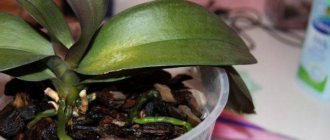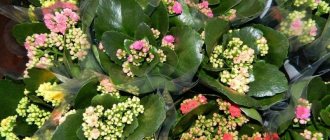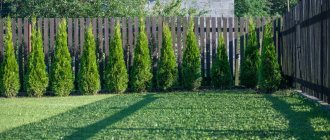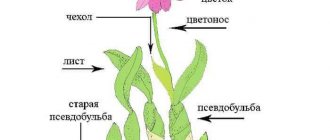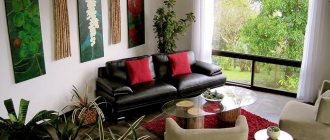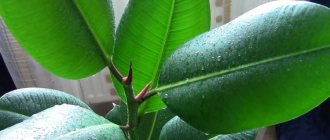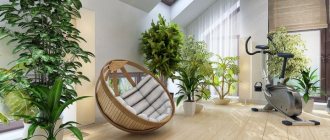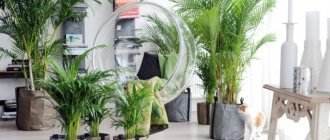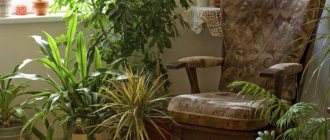Botanical characteristics
Common heather (Calluna vulgaris) belongs to the Veresaceae family. An evergreen shrub with widely branched stems and small triangular leaves that lack a petiole.
Tiny scale-like leaves are arranged in four vertical rows along the branches. This small shrubby plant usually grows less than 50 cm tall.
Common Names: red heather, Scottish heather
Type: broad-leaved evergreen.
Origin: native to Southeast Asia, Europe (i.e. Denmark, Ireland, Norway, Sweden, UK, Belgium, Czechoslovakia, Germany, Hungary, Netherlands, Poland, Switzerland, Belarus, Moldova, Russia, Ukraine, Albania, Bulgaria , Greece, Italy, Romania, Yugoslavia, France, Portugal and Spain), Morocco and Turkey.
Habitat: North America, northern Eurasia, Europe. Naturalized in Finland, New Zealand, Canada, northern USA and Alaska.
Flowering time: from July to September.
Reproduces mainly by seeds.
Sheet
Flower
Names of colors and shades (I continue to educate myself).
Hello, dear masters!
Again I found on my computer long-saved information from the Internet about the names of colors and shades (now not tables, but verbal descriptions). And again I decided to share with everyone: to be surprised by one - is it interesting? Yakhontovy, electrician, marengo. What is this. Very useful knowledge! But “Grey's last breath” or “Dauphine's surprise”. What kind of colors are these? If anyone is interested, please join. Let's expand our horizons.
The PS source of information has long been erased from memory.
——————————————————————————————————————————— Adelaide is a red shade of purple. According to other sources, dark blue. In the 40-50s of the XIX century. used in print: found in Turgenev (“Adelaide color, or, as we say, odelloid”) and Dostoevsky (“So this tie is Adelaide color? - Adelaide, sir. Isn’t there agraphen color?”).
Adrianople - bright red, from the name of the paint that was made from madder.
Hellfire, hellfire - a purple shade of red. Or pearlescent red. Or black with red streaks.
Alabaster - pale yellow with a matte tint.
Alizarin is the color of red alizarin ink.
Akazhu - the color of “mahogany”, from the French. acajou.
Amaranth is a color close to purple, violet. From the name of the plant “amaranth” - beauty, velvet, marigold, cockscomb (schirets - red grass). Or the color of rosewood wood, lilac-pink, light purple.
Amyanthus - the color of amianth (a type of asbestos): whitish, off-white. most of all - about the color of the sky.
Bakanovy (cormorant) - from “cormorant” - crimson dye extracted from the mealybug; fake, made of madder, etc.
The gaff is deep red with a bluish tint.
The thighs of the frightened nymph are a shade of pink. Perhaps it arose at the beginning of the 19th century with the advent of a new variety of roses. (There is also a “nymph’s thigh” color. It is pale pink, the nymph is calm.) According to other sources, it was pink with an admixture of ocher. Under Emperor Paul, the lining of military uniforms was painted this color. But since the fabric for officers and soldiers was of different quality, the officer’s shade was called “the thigh of a frightened nymph,” and the soldier’s shade was called “the thigh of a frightened Masha.”
Beryl - named after beryl, a transparent greenish-blue stone.
Biscuit - delicate grayish-green.
Biskr is a yellowish leather color for upholstery.
Bismarck furioso is brown with a red tint.
Bisnoy - gray, silver.
Bistre - the color of bistre, thick brown, brown.
Blanc, or planche (from the French blanc - white), is a creamy shade of white. Dahl has a flesh-colored, flesh-colored look.
Blockit - blue-blue. In Ukrainian, “blakitny” means blue.
Blond - the same as blond (fair-haired, blond).
Bordeaux wine is red-violet.
“Abdel-Kader’s beard” or “Abdel-Kerim’s beard” is a white material with a black tint and a gray tint.
Bristol Blue is a bright blue.
Lingonberry - once meant green (based on the color of the lingonberry leaf).
Brusyany, brusvyany - red, crimson, lingonberry colors.
Burny - the same as brown.
Busy - dark blue-gray or gray-blue.
White - blue. Woad was used instead of indigo.
Merry Widow is a shade of pink.
Verdepeche - a yellow or pink shade of green (similar to peach green).
Verdigris - green-gray, from the French. vert-de-gris.
Vermilion - bright red, the color of scarlet cinnabar, from the French. vermilion.
Toad in love - greenish-gray.
Crow's eye is black. It was recommended for fashionable tailcoats. This shade could be achieved using only high-quality wool (low-grade yarn acquired a reddish tint over time).
Waxed - the color of wax, from yellow-gray to amber yellow.
Havana is gray with a hint of brown or vice versa.
Haiti - either pink or bright blue.
Heliotrope - the colors of heliotrope, dark green with spots of red or yellow. Or like a heliotrope flower, grayish-purple.
Hyacinth - the color of hyacinth (stone), red or golden orange.
Flower formula
Inflorescences are racemose or umbellate. The inflorescence contains from 5 to 30 flowers. Flowers are small in size. Most often they are collected in one-sided brushes. The pink or pale purple bell-shaped flowers have four petals that form an inflorescence.
Small, bell-shaped (tubular) flowers hang downward (pendant-shaped). Each flower has eight stamens and four tiny petals (about 2 mm long), which are partly united in a short tube, and four large petal sepals (2-4 mm).
The petals and sepals are usually pale purple, although they can sometimes be pink or white.
MYRTOVYY
See what “MYRTLE” is in other dictionaries:
myrtle - oh, oh.
myrte m. outdated Color name. New beautiful ties appeared in Puglier's store: they are made of woolen velvet, patterned gros green and English woven satin; their color is different: dark red, myrtle, bronze and... ... Historical Dictionary of Gallicisms of the Russian language myrtle - MYRT, a, m. and MYRTLE, y, zh. Southern evergreen shrub or tree with white fragrant flowers. Ozhegov's explanatory dictionary. S.I. Ozhegov, N.Yu. Shvedova. 1949 1992 ... Ozhegov's Explanatory Dictionary
myrtle - adj., number of synonyms: 1 • myrsine (1) ASIS Dictionary of Synonyms. V.N. Trishin. 2013 ... Dictionary of synonyms
Myrtle - adj. 1. ratio with noun myrtle, myrtle, associated with them 2. Peculiar to myrtle, myrtle, characteristic of them. 3. Belonging to myrtle [myrtle 1.], myrtle [myrtle 1.]. 4. Consisting of myrtles [myrtle 1.], surrounded by myrtle [myrtle 1.]. 5. Made from flowers and... ...Modern explanatory dictionary of the Russian language by Efremova
myrtle - myrtle, myrtle, myrtle, myrtle, myrtle, myrtle, myrtle, myrtle, myrtle, myrtle, myrtle, myrtle, myrtle, myrtle, myrtle, myrtle, myrtle, myrtle, myrtle, myrtle, myrtle, myrtle, myrtle, myrtle, ... ... Forms of words
myrtle - myrtovy ... Russian spelling dictionary
myrtle - see myrtle; oh, oh. My/ortal leaf. My alley. My grove. World/mouth wreath... Dictionary of many expressions
myrtle - myrtle / ov / th ... Morphemic-spelling dictionary
myrtle wood warbler - karūnuotasis krūminukas statusas T sritis zoologija | vardynas atitikmenys: lot. Dendroica coronata engl. yellow rumped warbler vok. Kronwaldsänger, m; Myrtensänger, m rus. myrtle wood warbler, m pranc. paruline à croupion jaune, f ryšiai:… … Paukščių pavadinimų žodynas
Source
Chemical composition
The inflorescences of common heather have a fairly diverse chemical composition. The main compounds that make up this plant are carbohydrates, followed by protein, carbon lipids.
It is possible to identify sucrose, fructose and glucose, five organic acids, 26 individual fatty acids and four tocopherol isoforms. As for the composition of the extract, it contains 12 phenolic compounds with a predominance of myricetin-3-O-glucoside and myricetin-O-rhamnoside.
Regarding biologically active effects, the more polar extracts have not only the highest amount of phenolic compounds, but also the strongest antioxidant and antibacterial activity. In contrast, for anti-inflammatory and cytotoxic potential, the most effective extracts were n-hexane and ethyl acetate, respectively.
The antimicrobial activity of phenolic compounds from heather is also significant.
The plant also contains vercetin, arbutrase enzyme, citric and fumaric acids, starch, resins, gum, flavonoids, carotene, potassium compounds, phosphorus, sodium, organic acids, coumarins, steroids
Winter type.
| The skin of people with spring type has a warm peach tint. Hair color between light red and blond. Spring types refer to people who particularly suit radiant and fresh tones. Warm colors highlight the golden tone of the skin. Of the red tones for the spring type, gradations from orange-red to coral and light rusty red are best suited. Orange tones and shades of peach, salmon and apricot are perfect. Warm natural tones, white wool, beige and camel. All shades of green will do. From bright to delicate. For example, apple greens and yellow-greens. Warm sunny yellow color harmonizes perfectly with the spring palette. You need to be careful when choosing shades of blue. Their selection is limited for the spring type, with the exception of turquoise, aquamarine and light gray-green-blue. In black, the spring type looks pale, as the contrast is too strong for his skin. |
| Summer-type skin has a delicate pink tint. Hair color ranges from blond to dark brown with a golden tint. People of this type have a wide color palette. All smoky and gray tones will suit them. Shades of blue and denim are good. You can choose from gray-blue to dark blue of all nuances. Cherry or burgundy are great colors. Green: menthol to dark green and preferably with a bluish tint. Pastel colors like lilac, rose and pink are optimal. Yellow, orange and apricot colors are not recommended. Better lemon soft, white or dark gray. Clothes in bright or warm clay colors will highlight skin imperfections and a summer-type person will look pale and unhealthy. |
| Autumn, like spring, is painted in warm colors characteristic of these seasons. Autumn hair color ranges from golden to dark brown with hints of red. From chestnut to copper-red-brown palette. Autumn colors include all the tones that are inherent in autumn in nature. Primarily warm and earthy shades. Muted gold tones, orange and shades of red are especially suitable for the autumn type. Warm greenish, such as olive, but also khaki and the palette is gray-greenish-blue. Brown and beige colors are also suitable, preferably with a gold tone. Mustard and corn yellows, as well as brass, enrich the color palette. White and black colors are problematic for the autumn type. They cast strong shadows on your face and therefore make you appear older. |
| Winter type people are striking in their contrasts. Like a winter snowy landscape. The skin tone is bluish, like summer skin. The complexion often looks clear and cool. In most cases, hair forms a strong contrast with the complexion of the face. From black to dark brown. All luminous and lively colors suit the winter type, as do white and black. Cool luminous red, hot pink and fashionable lilac complement the color of the skin. To this you can add the entire gray palette from anthracite to black and dark brown. From bright green to dark green, cool turquoise, as well as bright cobalt, ice blue or dark blue. Earthy tones do not suit this contrasting type. Clear and luminous colors highlight the cool clay tone of the skin. |
Active ingredients
Heather leaves represent a very promising source of triterpenoids.
Numerous triterpenoids, including ursolic and oleanolic acids, have antitumor and anti-inflammatory properties. A new property of ursolic acid has been described in heather acetone extract that may help explain the plant's anti-inflammatory properties.
The quercetin content may explain the plant's nerve-soothing effect. The aqueous extract has the highest phenol content.
Description
The unpretentious plant is a slow-growing shrub with creeping shoots rising 30–40 cm above the soil surface. Small leaves of heather can be painted in various colors: green, silver, red, bronze, yellow. Heather blooms from August to October; many small fragrant flowers of white, pink, crimson or dark blue bloom on the plant.
Interesting! Heather is the national flower of Norway. And in Polish, Belarusian and Ukrainian languages, the autumn month of September is named after this plant (Veresen, Vryzen).
Indications for use
Heather has a long history of medicinal use in folk medicine. In particular, it is a good urinary antiseptic and diuretic, disinfecting the urinary tract and slightly increasing urine production. This is why the plant is traditionally used to treat urinary tract infections and inflammatory diseases.
Heather is used in ethnopharmacology as an antiseptic, antibacterial, choleretic, diuretic, expectorant, antirheumatic and anti-inflammatory agent. Several studies have revealed the antioxidant, antitumor and anti-inflammatory properties of heather extract.
Previous studies have shown the activity of heather in the treatment of inflammatory diseases and wounds in Swedish folk medicine. A large number of plant species are used in Danish folk medicine to treat depression and anxiety.
Flowering shoots are antiseptic, astringent, choleretic, diaphoretic, diuretic, expectorant, mildly sedative and vasoconstrictor.
The plant is often collected and made into liniment to treat rheumatism and arthritis, while a hot poultice is a traditional remedy for chills. Always seek the advice of a professional before using a plant for medicinal purposes.
RAL colors
RAL is an international color matching system that is in demand today in almost all industries. The standard has taken a dominant position in industry, commerce, architecture and design. Leading Russian and Western companies use RAL colors in their production.
The RAL color standard begins its history in 1927, when specialists from the German Trade Standards Authority first developed a collection that at that time consisted of 40 colors. Since then, the RAL palette has been constantly expanding. The company produces color catalogs and fans containing examples of RAL paints, develops and adds new samples.
Our website contains all three modern color scales, RAL tables with CMYK and RGB layout.
Select RAL color catalog:
Features of common heather
Because common heather produces a persistent layer of leaf litter, the area where it grows is often virtually devoid of other plant species. This ability to dominate and crowd out root vegetation leads to severe loss of biodiversity and reduced habitat available to native animals. It can colonize up to 1500 m² and is therefore considered a serious threat to the ecosystem.
This is of great concern in many countries where heather covers approximately 6,000 square kilometers. In Tongariro National Park it is the most common exotic weed species and competes with a wide range of native plants.
This is also a concern along the Atlantic coast of North America (Quebec, New Jersey). Because it grows in alpine and subalpine grasslands, heather also has the potential to reduce highland grassland productivity if it becomes widely naturalized in south-eastern Australia.
Conditions for successful cultivation in open ground
All varietal heathers are unusually light-loving. They need a completely open and well-lit area where the sun shines from dawn to dusk. At the same time, they can withstand light partial shade. But then the flowering will not be so abundant, rather single faded flowers will appear.
It is better to place the heather in the openwork shade of trees at a sufficient distance, or near a lattice fence. The northeast side is preferable. The afternoon shade will cover the tender bushes
In bright light the color of the flowers is rich and deep, in the shade it is pale. Inflorescences become small and sparse. They lose the decorative effect for which they were planted.
Under the protection of trees such as birch, heather tolerates winter well. But the crown of the bush will not be thick and lush as in the light. And flowers are unlikely to appear in the shade.
Although species heather is a light-loving plant, decorative forms prefer light shading in the second half. It is especially important to protect them from the scorching heat.
Due to the characteristics of the roots and crown, heather is quite resistant to wind. But this does not mean that it can be planted in windproof plantings or constant drafts. Even the most resistant varieties are afraid of strong turbulence.
We are planning to plant “Calunea” in the garden, it is worth making sure that the area is never flooded, even after the snowiest winters and during periods of prolonged rain. They absolutely cannot tolerate waterlogging. The bushes quickly die from excess moisture.
But, if the groundwater does not rise above 1 meter to ground level, this is quite suitable for drought-resistant bushes. The shallow root system will not reach the water.
Heather is usually planted separately from other plants because it needs poor, dry soil, unlike most garden plants which grow in rich, fertile soil. The plant substrate should be given special attention.
Soil structure and composition
The easiest way is to buy a ready-made mixture for rhododendrons at a specialized garden store . It is usually sold in the same place as azalea, heather, andromeda and erica, that is, representatives of the Heather family.
You can prepare the necessary soil for heather yourself
The package indicates a pH level of 4.5 - 5.5, as well as the composition, which includes:
- high peat
- grassland peat
- crushed pine bark or rotted litter
If the soil on your site is rich and fertile, it will have to be completely removed and replaced with a ready-made substrate.
When the required soil is not available, it is prepared independently by combining the following components:
- The basis is coniferous soil, which is collected from the forest along with rotted spruce or pine needles. You will need a top layer of 5 - 8 cm
- add high-moor peat with a strongly acidic reaction pH 3.2. It is easily recognized by its characteristic bright red color and coarse-fiber structure.
- for aeration you will need coarse river sand
You should not collect sand for him in the meadow. It is called ravine. It contains clay impurities that are unsuitable for growing heather.
Ratio in parts:
- peat – 3
- sand – 1
- coniferous land – 2
To know exactly the amount of mixture, you need to determine the size of the planting hole.
Technology and planting timing
Bushes are planted in spring or late September
A planting hole for one bush is prepared measuring 30 cm in diameter and the same depth. The volume of excavated soil is 0.027 m3 or 27 liters. This is exactly how much you need to buy or prepare mixtures for one plant.
If the natural soil at the dacha is clayey, then the hole is dug 15–20 cm deeper and drainage material is placed at the bottom to avoid stagnation of water. Usually crushed stone or broken brick mixed with sand is used.
Concrete or slate cannot be used for drainage; they alkalize the soil, that is, reduce acidity.
It is better to fill the hole in the fall and plant the heather in the spring. Specialists from the National Botanical Garden of St. Petersburg recommend adding to the soil for bush survival:
- nitrophoska – 20 g for low-growing varieties and 30 g for large ones
- horn flour – 30 – 50 g
In order for heather to tolerate planting well, you only need to buy plants in a container with a lump of earth. It is very difficult for seedlings with an open root system to take root, because the biological symbiosis of the root system and fungal mycorrhiza, without which the plant cannot exist, is disrupted. It is better to purchase specimens where the hyphae are completely preserved, which significantly improves the adaptation of heather to a new location.
When choosing a seedling, pay attention to its appearance:
- The branches should be flexible and completely covered with small light green leaves. The lower part of the shoots is woody, the ends of the stems are green
- When you remove the plant from the package, the lump should not fall apart and be slightly moist, but not wet. Excess moisture will cause the death of the plant
One of the indicators of good condition is the tight fit of the lump to the container. Then, air does not reach the roots and dry them out.
Bushes are planted in spring or late September. Experts recommend planting in late April early May. During this growing season, all plants begin to grow. A warm summer is ahead and there is enough time to overcome stress and take root in a new place.
Fall planting is especially undesirable for imported plants brought from warmer climates. In a short time they will not have time to adapt before the first frost, therefore, they may not survive the winter.
When planting, the lump is placed at the level of the upper edge of the planting hole. Heather cannot be buried, otherwise it will not take root.
Immediately after planting, the heather is watered abundantly and mulched with a thick layer of coniferous bark, needles, and cones.
If you plan to plant a heather garden, the unsuitable soil is removed from the allotted area to a depth of 30–40 cm and completely replaced with a peat mixture.
How many plants need to be planted depends on their size. Recommended planting rate per square meter:
- Three large bushes are enough
- low-growing heathers fit from eight to twelve
The interval between them is 30–40 cm. To ensure uniform overgrowth, the bushes are placed in a checkerboard pattern. In the border they are planted in one line. The age of the heather at the time of planting is also important. It is better to buy seedlings that are one and a half to two years old.
Main types and varieties of plants
There are several varieties of heather.
Green foliage variety
'Winter Chocolate' is a low-growing shrub that begins with yellow foliage in the spring that turns green and orange in the summer and brown in the fall and winter. Small lavender-colored flowers bloom from summer until fall.
Variety with white flowers and green leaves
Heather variety "Alpina" is a medium-sized evergreen shrub: up to 2 m in height, with bright green foliage. This variety has small, fragrant white flowers.
Variety with silver foliage
Silver-leaved heather is a large shrub (up to 2 m tall) with relatively small (3-5 mm long) white or pale pink flowers that turn brown as they age. Its elongated leaves (3-7 mm long and less than 1 mm wide) appear in inflorescences of three or four pieces.
Green foliage variety
Variety with white flowers and green leaves
Variety with silver foliage
Variety with golden foliage
Heather 'George Hunt' is a plant with luxurious golden yellow foliage. Height up to 1.5 m. Fragrant, white flowers open from pink buds from late winter to mid-spring.
Variety with double flowers
Originally from England, where it was bred in 1935. The height of this spherical shrub is from 30 to 40 centimeters. The most important feature of this variety is the double lush flowers, which are collected in a huge number of inflorescences. This variety grows well in areas with sufficient light and moderate humidity. It practically does not tolerate excessive watering.
Variety with unopened flowers
An interesting option are plants that allow the flower to remain in the shape of a bud and never open. This variant has been used by breeders (Garden Girls™) to produce numerous forms with white ("Klaudine"), pink, purple and red ("Athene") buds. Because the flowers do not open and cannot be pollinated (do not attract bees), they retain their color for a long period, often into early winter.
Variety with golden foliage
Variety with double flowers
Variety with unopened flowers
How to create a fashionable styling with a heather shade in the leading role?
The most fashionable stylizations with heather should start with everyday proposals. For casual outfits, choose a light purple blouse and pair it with a pleated pink midi skirt. Put white sneakers . For hot days, choose a lavender Spanish cropped top and pair it with trendy shorts. The top will accentuate your tan and the high-waisted bottom will highlight your waistline. In smart casual sets, you can choose a pencil dress and add a loose jacket in a heather shade to it. The perfect complement to the set are espadrilles with wedge ties (another trend this summer!). Looking for a more elegant and more feminine proposal? A heather jumpsuit paired with white high heels is sure to make a splash. A slightly more sensual option is a delicate heather-colored dress, decorated with thin lace on the neckline. Pair it with gold heeled sandals.
Unpretentious guest
Heather is very easy to grow and care for. It reproduces well and quickly conquers neighboring territories. Also, this plant does not require frequent watering. Sometimes it is necessary to control the acidity of the soil.
Growing on site
Common heather flowers are grouped into umbels and bloom from autumn to winter. This perennial plant usually covers surfaces well enough to look pretty, and its fluffy appearance and abundant flowers are sure to be a wonderful addition to your garden.
Although it blooms for over 5 months of the year, common heather requires little care and adapts equally well to rocks, edges and mounds, as well as garden boxes.
Balconies and terraces are ideal places for this plant because growing in pots is ideal and its low maintenance requirements make it easy to care for.
Heather in pots
What time does disembarkation take place?
With careful planning, heather flowering can occur from June to November. Heather can be planted at any time of year when the soil is workable, in an area that receives a minimum of 4-6 hours of full sun each day, except in hot summer regions. Lack of sunlight will result in poor growth.
Planting heather in open ground
Before planting, mix a generous amount of peat moss, compost or other organic material (no manure) into well-drained, sandy or gritty soil. Heathers are acidic soil plants.
Check and adjust soil acidity to maintain a pH of 4.5-6.0. Heather needs light sandy soil enriched with organic matter. Plant your heather so that the root ball is at the same soil level as it grew.
Growing
Seedling care
Unfortunately, despite its obvious appeal, Scottish heather is difficult to grow in the south. This attractive plant grows best where conditions are not too hot, not too cold, not too dry and not too wet, and should be grown in highly acidic, sandy or peaty, well-drained soil that is low in nutrients.
You can supplement the soil with organic matter, but do not fertilize. Avoid growing close to the plant as this may damage the small roots. Mulch thoroughly to help cool the soil and retain moisture.
Water regularly to keep the soil evenly moist but never soggy. Heather plants require little or no fertilizer, but if the foliage turns pale or flowering declines, it is necessary to feed them in late winter or late spring using an acid or rhododendron fertilizer.
Heather in open ground does not need feeding if conditions are acidic. If the soil becomes too alkaline, yellowing of the foliage may occur. In this case, feed with acid fertilizer in late March or early April. Fertilizer should be applied around the drip line.
After fertilizing, the plant should be watered abundantly.
Heathers should be pruned by cutting off spent flower spines immediately after they have finished blooming, except for late autumn and winter bloomers, which should be trimmed in early spring.
For the first two or three years after planting, prune the stem back by two-thirds. Heather is a shallow rooted plant so always take care when growing and weeding around it.
Pruning heather
Pests and diseases
Soggy soil can lead to root and stem rot or fungal diseases of heather. Heathers can suffer from Phytophthora root rot, especially in warmer climates. This plant is a favorite treat of deer and rabbits.
Heather propagation
Common heather reproduces mainly by seeds, which can remain viable for a long period (i.e. up to 100 years). Vegetative propagation can also occur through a process known as debranching, where branches, when in contact with the soil, take root and form new plants.
Seeds are spread by wind and by vehicles, animals or pedestrians that come into contact with the plants. Heather plants can be propagated from cuttings taken in early summer.
Heathers are self-layering and root wherever their stems are in contact with the soil. Rooted segments can be easily cut and replanted.
Fresh heather seeds can be sown as is, but if the seeds have been dried and stored, they should be placed in a moist growing medium and refrigerated for 4 weeks before planting. Seeds sown indoors will germinate in about a month if they are stored at a temperature of 65 C -70 C.
Heather after flowering
Flower buds begin to develop during autumn, and flowering occurs mainly in winter. When the fruits begin to ripen, the petals turn brown and dry out, and the flower sags in an upright position. The calyx is longer than the corolla.
Heathers do not regenerate well from old wood, so once they have become large enough, replacement is the best option. Alternatively, consider propagating the plant by "dropping"
Shades of green. Color Chart
» News » Shades of green. Color Chart
Shades of green are 376 tones (in the Pantone palette), light, medium and dark, bright and dull, cold and warm, with gray, brown, yellow, blue undertones. Wide range from pastel to dark, from cold to warm colors. You will see how wide and varied the range of green spectrum is, and you will be able to choose the best shade for yourself. Colors in the Pantone system in the TCX category - a palette for clothing and interior textiles. It is from these shades that fashion trends are selected and announced on the catwalk. Shades of pink designed in the form of a color table: color dies, number in the system, color name. The site also has a section dedicated to shades of green and their combinations.
See other colors
| white-green color 11-0410 TCX | air green 11-0609 TCX | mystical meadow color 12-0106 TCX | Canary green 12-0108 TCX |
| Ambrosia color 12-0109 TCX | green patina color 12-0225 TCX | asparagus green color 12-0311 TCX | lime cream color 12-0312 TCX |
| seafoam color 12-0313 TCX | white jade color 12-0315 TCX | light pale green 12-0317 TCX | butterfly color 12-0322 TCX |
| straw color 12-0418 TCX | soft green 12-0426 TCX | Daiquiri Green 12-0435 TCX | pale lime 12-0520 TCX |
| young wheat color 12-0521 TCX | citrus color 12-0524 TCX | light green 12-0525 TCX | wild mustard color 12-0530 TCX |
| Green Essence Color 12-0607 TCX | grey-yellow 12-0619 TCX | lemon glass color 12-0626 TCX | sunny lime color 12-0741 TCX |
| bay color 12-5507 TCX | Cantaloupe color 12-5808 TCX | dew color on sheet 13-0107 TCX | wave crest color 13-0111 TCX |
| color green pastel 13-0116 TCX | ash green 13-0117 TCX | haze green 13-0210 TCX | soft green 13-0212 TCX |
| cane color 13-0215 TCX | paradise green 13-0220 TCX | pistachio color 13-0221 TCX | water lily green 13-0317 TCX |
| lime shadow color 13-0319 TCX | lime green color 13-0324 TCX | juice green color 13-0331 TCX | Shine Green 13-0442 TCX |
| pale green 13-0522 TCX | lime sherbet color 13-0530 TCX | celery green 13-0532 TCX | piercing green 13-0535 TCX |
| wild lime color 13-0540 TCX | lime punch color 13-0550 TCX | wet scarlet color 13-0608 TCX | chicory color 13-0632 TCX |
| lime color front 13-0645 TCX | spring sulfur 13-0650 TCX | Yucca color 13-5409 TCX | beach glass color 13-5412 TCX |
| ice green 13-5414 TCX | cabbage color 13-5714 TCX | Gas Green 13-5907 TCX | bird egg green color 13-5911 TCX |
| green close to the color of water 13-6006 TCX | color green splashes 13-6007 TCX | color smoky jade 13-6008 TCX | color green stream 13-6009 TCX |
| green shade 13-6106 TCX | Lily Green 13-6107 TCX | aqua 13-6108 TCX | Fog Green 13-6110 TCX |
| bok choy color 13-6208 TCX | sea green 14-0114 TCX | green foam color 14-0115 TCX | color green Nile 14-0121 TCX |
| Arcadian Green 14-0123 TCX | Renclad color 14-0127 TCX | summer green 14-0156 TCX | fiber color 14-0216 TCX |
| seedling color 14-0217 TCX | Nile color 14-0223 TCX | opal green color 14-0226 TCX | jade lime color 14-0232 TCX |
| bright lime green 14-0244 TCX | bog color 14-0418 TCX | beechnut color 14-0425 TCX | banana green 14-0434 TCX |
| color bright chartreuse 14-0445 TCX | Tender shoot color 14-0446 TCX | lime green 14-0452 TCX | Haze Green 14-0615 TCX |
| celery yellow 14-0647 TCX | Harbor Gray 14-4908 TCX | relaxing green shade 14-5413 TCX | Bermuda color 14-5416 TCX |
| Cockatoo color 14-5420 TCX | mud green color 14-5706 TCX | water foam color 14-5707 TCX | ocean wave color 14-5711 TCX |
| waterfall color 14-5713 TCX | green plexiglass color 14-5714 TCX | opal color 14-5718 TCX | electric green 14-5721 TCX |
| seafoam color 14-6007 TCX | soft green 14-6008 TCX | Jade Gray 14-6011 TCX | color green Neptune 14-6017 TCX |
| cameo green 14-6312 TCX | spruce stone color 14-6316 TCX | meadow color 14-6319 TCX | pea pod color 14-6324 TCX |
| Marshmallow Green 14-6327 TCX | Absinthe Green 14-6329 TCX | spring bud color 14-6330 TCX | spring bouquet color 14-6340 TCX |
| green flash color 15-0146 TCX | tarragon color 15-0326 TCX | Leaf Green 15-0332 TCX | garden grass color 15-0336 TCX |
| Parrot Green 15-0341 TCX | green color 15-0343 TCX | pale olive 15-0522 TCX | winter pear color 15-0523 TCX |
| Weeping willow color 15-0525 TCX | Sweet Pea 15-0531 TCX | lime green 15-0533 TCX | palm color 15-0535 TCX |
| oasis green color 15-0538 TCX | apple green 15-0543 TCX | jasmine green 15-0545 TCX | Sitronyl color 15-0548 TCX |
| leek color 15-0628 TCX | gold with green tint 15-0636 TCX | watercress color 15-0643 TCX | fresh olive color 15-0646 TCX |
| blue-turquoise color 15-5217 TCX | pool color 15-5218 TCX | Florinsky keys color 15-5416 TCX | water green 15-5421 TCX |
| Atlantis color 15-5425 TCX | waterfall shade 15-5516 TCX | turquoise color 15-5519 TCX | bright green 15-5534 TCX |
| ice green 15-5706 TCX | Dusty Green Jade 15-5711 TCX | Bay of Biscay Green 15-5718 TCX | mint leaf color 15-5728 TCX |
| lichen color 15-5812 TCX | mint color 15-5819 TCX | hemlock color 15-6114 TCX | Ming Dynasty Green 15-6120 TCX |
| jade cream color 15-6123 TCX | marsh color 15-6310 TCX | laurel green 15-6313 TCX | Smog Green 15-6315 TCX |
| show green 15-6316 TCX | muted green 15-6317 TCX | light green glass color 15-6322 TCX | Irish Green 15-6340 TCX |
| pale green 15-6414 TCX | forest shade color 15-6423 TCX | green tea color 15-6428 TCX | trefoil color 15-6432 TCX |
| green glass color 15-6437 TCX | bud green color 15-6442 TCX | Desert Sage 16-0110 TCX | green swirl color 16-0123 TCX |
| green tea shade 16-0213 TCX | mistletoe color 16-0220 TCX | green eye color 16-0224 TCX | Jade Green 16-0228 TCX |
| Macaw Green 16-0230 TCX | glade green color 16-0233 TCX | kiwi color 16-0235 TCX | leaf color 16-0237 TCX |
| sage color 16-0421 TCX | fern color 16-0430 TCX | dark candied fruit color 16-0435 TCX | spinach green 16-0439 TCX |
| cedar color 16-0526 TCX | moss color 16-0532 TCX | oasis color 16-0540 TCX | elm color 16-0613 TCX |
| willow color 16-0632 TCX | polished gold color 16-0737 TCX | wasabi color 16-5109 TCX | Cantonese Green 16-5112 TCX |
| dusty turquoise shade 16-5114 TCX | sea color 16-5119 TCX | jade shade 16-5304 TCX | agate green 16-5412 TCX |
| lagoon color 16-5418 TCX | sea green shade 16-5421 TCX | bright water color 16-5422 TCX | Pool Green 16-5425 TCX |
| billiard color 16-5427 TCX | peacock green 16-5431 TCX | beryl green 16-5515 TCX | Arcadian Green 16-5533 TCX |
| sea green 16-5721 TCX | Planet Green 16-5806 TCX | water lily leaf color 16-5807 TCX | Iceberg Green 16-5808 TCX |
| Bay Green 16-5810 TCX | spar green 16-5815 TCX | spruce green 16-5820 TCX | candy green 16-5825 TCX |
| granite green color 16-5907 TCX | malachite green 16-5917 TCX | creme de menthe color 16-5919 TCX | cool green 16-5924 TCX |
| Ming Dynasty Green 16-5930 TCX | leaf green 16-5932 TCX | menthol color 16-5938 TCX | flattering green 16-5942 TCX |
| grasshopper color 16-6030 TCX | color slate green 16-6116 TCX | Rosehip Green 16-6127 TCX | pure green 16-6138 TCX |
| basil color 16-6216 TCX | Island Green 16-6240 TCX | green crystal color 16-6318 TCX | jade glitter color 16-6324 TCX |
| mint color 16-6329 TCX | pulsating green 16-6339 TCX | classic green 16-6340 TCX | poison green 16-6444 TCX |
| oil green color 17-0115 TCX | peat green 17-0119 TCX | green stone color 17-0123 TCX | fluorite green 17-0133 TCX |
| lime color online 17-0145 TCX | Warm Loden 17-0210 TCX | aspen color 17-0215 TCX | watercress color 17-0220 TCX |
| forest green 17-0230 TCX | spicy green 17-0235 TCX | Epson Green 17-0324 TCX | tortoise green 17-0330 TCX |
| peridot color 17-0336 TCX | Moss shade 17-0525 TCX | olive green 17-0535 TCX | moss green 17-0636 TCX |
| beige-olive color 17-0836 TCX | bronze fog color 17-0843 TCX | dull gold 17-0935 TCX | deep peacock blue 17-5029 TCX |
| lapis color 17-5034 TCX | Chinese green 17-5107 TCX | trellis green color 17-5110 TCX | blue-green oil color 17-5111 TCX |
| slate blue color 17-5117 TCX | bay color 17-5122 TCX | blue-green color 17-5126 TCX | Columbia green 17-5130 TCX |
| Dynasty Green 17-5330 TCX | green spectrum color 17-5335 TCX | porcelain green color 17-5421 TCX | Alhambrian green 17-5430 TCX |
| deep sea color 17-5513 TCX | Lake Green 17-5528 TCX | deep green 17-5633 TCX | bright green 17-5638 TCX |
| emerald color 17-5641 TCX | green bottle color 17-5722 TCX | Python Green 17-5734 TCX | Parrot Green 17-5735 TCX |
| dark ivy color 17-5912 TCX | pine green 17-5923 TCX | plain green 17-5936 TCX | deep menthol color 17-5937 TCX |
| laurel wreath color 17-6009 TCX | green color Jeli Bina 17-6030 TCX | fern green 17-6153 TCX | green shade color 17-6206 TCX |
| Marine spray color 17-6212 TCX | deep green glass 17-6219 TCX | medium green 17-6229 TCX | cashmere green 17-6319 TCX |
| Hedge Green 17-6323 TCX | menthol green 17-6333 TCX | dill color 18-0108 TCX | English ivy color 18-0110 TCX |
| Vineyard Green 18-0117 TCX | willow branch color 18-0119 TCX | elm green 18-0121 TCX | artichoke green 18-0125 TCX |
| cactus color 18-0130 TCX | tree crown color 18-0135 TCX | pestle color 18-0228 TCX | deep lichen color 18-0312 TCX |
| olive color 18-0316 TCX | bronze green 18-0317 TCX | cypress color 18-0322 TCX | colista green 18-0324 TCX |
| cedar green 18-0328 TCX | grasshopper color 18-0332 TCX | four leaf clover 18-0420 TCX | Loden Green 18-0422 TCX |
| olive color Capulet 18-0426 TCX | avocado green 18-0430 TCX | calla green 18-0435 TCX | iguana color 18-0525 TCX |
| olive branch color 18-0527 TCX | honeysuckle green 18-0538 TCX | olive color with gray tint 18-0622 TCX | spruce green color 18-0627 TCX |
| lizard color 18-0629 TCX | gothic olive color 18-0724 TCX | caper color 18-0820 TCX | interior color 18-0825 TCX |
| walnut gray 18-0830 TCX | plantation color 18-0832 TCX | tropical green 18-4930 TCX | brass band color 18-4936 TCX |
| parachute green color 18-5020 TCX | pine sea color 18-5112 TCX | North Sea color 18-5115 TCX | river color 18-5121 TCX |
| grass blue 18-5128 TCX | blue spruce color 18-5308 TCX | bayberry green 18-5315 TCX | alpine green 18-5322 TCX |
| ultramarine green 18-5338 TCX | silver pine color 18-5410 TCX | antique green 18-5418 TCX | cadmium green 18-5424 TCX |
| dark forest color 18-5611 TCX | Mid Green 18-5612 TCX | green bouquet color 18-5616 TCX | jungle color 18-5618 TCX |
| Tidal Pool Color 18-5619 TCX | ivy color 18-5620 TCX | spruce color 18-5621 TCX | spruce drizzle color 18-5622 TCX |
| Shady Glade Color 18-5624 TCX | bosphorus green 18-5633 TCX | golf green 18-5642 TCX | smoky pine color 18-5718 TCX |
| Galapogos Green 18-5725 TCX | green pepper color 18-5841 TCX | garden topiary color 18-5913 TCX | green duck color 18-6011 TCX |
| leaf green 18-6018 TCX | gnome color 18-6022 TCX | Amazon color 18-6024 TCX | myrtle color 18-6114 TCX |
| Comfrey 18-6216 TCX | golf course color 18-6320 TCX | juniper color 18-6330 TCX | garden green shade 19-0230 TCX |
| thyme color 19-0309 TCX | Beetle Green 19-0312 TCX | dark forest color 19-0315 TCX | garlic green color 19-0323 TCX |
| color of night in the forest 19-0414 TCX | duffel bag color 19-0415 TCX | kombu green 19-0417 TCX | rifle green color 19-0419 TCX |
| rosin color 19-0509 TCX | beech color 19-0618 TCX | military olive color 19-0622 TCX | mallard green 19-4818 TCX |
| green roof color 19-4906 TCX | dark turquoise green 19-4922 TCX | dark spruce color 19-5212 TCX | storm green 19-5217 TCX |
| swamp green 19-5226 TCX | Pacific Pine 19-5320 TCX | bistro green 19-5408 TCX | trekking green 19-5411 TCX |
| Jasper Green 19-5413 TCX | Junebug color 19-5414 TCX | spring green color 19-5420 TCX | treasure hunter green 19-5511 TCX |
| dark green 19-5513 TCX | Jungle Green 19-5914 TCX | sycamore color 19-5917 TCX | pine color 19-5920 TCX |
| Green Green 19-6026 TCX | deep forest color 19-6110 TCX | Green Pasture Color 19-6311 TCX |
See other colors
USEFUL ARTICLES ON THIS TOPIC (click on the picture)
One comment on “Shades of Green. Color table"
- Lyudmila Pavlovna
January 9, 2015, 3:14
Thank you very much for such work! I looked through all the color charts. Thank you for providing not only the numerical data from the table, but also the names. In other countries, color names are many and varied. Ours was green. light green and light and dark. I heard some colors for the first time at Fashion Verdict. A long time ago I bought tables for industrial use. The color could even be named using numbers. When catalogs began to arrive to us, I translated the names of flowers from the German. But the choice there is also a little limited. And in your tables there are so many names and all are clear (except for single names)! Thank you!!!
leave a comment
(Only in Russian)
Use in everyday life
Heather honey is especially popular. This honey has a pure amber color with reddish hues, an intense and persistent aroma of heather flowers and a sweet taste with a bitter and salty undertone.
It is collected from the hives in August. It retains all its numerous properties by maintaining them in optimal quality, in the most natural form, during the entire process, from production to receipt of the packaged product.
Purple heather flowers are mentioned in many Scottish poems and songs. The tips of the bush are eaten by grazing animals, and clusters of flowering heather are often collected for decoration. In the past, heather was also used to make bitter Scottish beer.
Recently, common heather has become a popular raw material for the production of biofuels. It can and does grow in areas considered unsuitable for biomass cultivation. In the UK, heather vegetation is regularly controlled by burn management and lost biomass could be harvested instead. Heather is an effective energy crop.
The energy efficiency of this plant puts it on par with fossil fuels such as coal and peat. Although heather is primarily used for decorative purposes, its potential as a biofuel feedstock is quite large.
Heather honey
Who is heather color suitable for?
We love heather for its versatility. Each of us can include it in our styling and look beautiful. And although it is often associated with romance, older women can also safely gravitate towards this shade. It is enough to choose the right cut of trousers, skirt or dress to look good in this color and feel comfortable. If you are not convinced by the delicate violet color in your clothes, wear accessories of this shade. Heather earrings, a necklace or a handbag will add charm to your look without being obtrusive. Heather shoes - both with heels and flats - will also be an ultra-fashionable solution. A heather-colored dress is a proposal for romantics who love a delicate base. This season, lavender-colored models, decorated with flowers, openwork inserts and frills, predominate. Spanish necklines and mini lengths in a powdery purple version look phenomenal on both fair-skinned blondes and fashionistas with darker hair. So, if you like to keep up with the latest trends, heather is a must-have color in your wardrobe!
Traditional medicine recipes
The powder of the plant's flowers helps with skin diseases. To treat diseases of the throat and oral cavity, diseases of the nervous system, a decoction is used: place 20 g of heather in a 200 ml container, pour boiling water. Place the mixture in a water bath for 15 minutes, then leave for 3⁄4 hours and strain. Heather tea (1 tsp/200 ml of water) with the addition of honey helps eliminate insomnia and nervous tension.
For pulmonary tuberculosis, heather tincture is used. Tincture recipe: pour 10 g of plant roots with 50 ml of 70% alcohol, leave for 2 weeks. After straining, take 40 drops (less than a teaspoon) before eating.
Baths with heather infusion also have a calming and relaxing effect.
Color combination: table
Pure color dyes are rarely used in the textile industry. Most often, fabrics of various shades and transitions of pure colors are produced.
Primary colors
Harmonizing colors and shades
Inharmonious colors and shades
Red
Colors: warm red, terracotta, orange, pink (mostly), shades of brown, olive
Warm red
The color of green grass, shades of yellow, achromatic (white, black and gray), blue
Terracotta, orange, black, purple colors
Pink
Blue, burgundy, gray, brown, light blue, shades of green
Warm shades of red, gold, chestnut, orange, olive
Orange
Violet and lilac, blue, green, yellow-green, brown, white
Red, pink, purple
Terracotta color
Indigo, sea green, warm green, orange, blue, olive
Violet, pink, purple, lilac
Brown
Olive, golden, gray, blue with a greenish tint, beige.
Bordeaux, chestnut, lilac, pink.
Chestnut
Green, olive, golden, ultramarine, mignonette, lilac, gray.
Red, burgundy, pink.
Canary
Greenish-yellow, violet, lilac, yellow-green, ultramarine.
Golden
Ultramarine, pure red, dark green, sky blue, purple, violet, dark gold, olive, brown, gray.
Mignonette color, pink, lilac.
Yellow
Green, brown, golden
Bordeaux, myrtle, pink.
Yellow-green
Bright scarlet, brown, cinnabar, violet, purple, blue, yellowish green.
Ultramarine, sky blue, golden yellow.
Olive
Blue, brown, gray, chestnut, golden, ultramarine, greenish blue, dark olive, orange, green, red.
Bordeaux, myrtle, mignonette color, lilac, pink.
Green herbal
Blue, yellow, orange.
Mignonette color
Brown, chestnut, red, pink, lilac, gray.
Blue, green, olive, burgundy, myrtle, gold, ultramarine.
Sea water color
Brick, cinnabar, yellow.
Myrtle
Blue, brown, red, burgundy, chestnut, ultramarine, gray.
Green, olive, golden, mignonette, lilac, pink,
Blue
Red, brick, cinnabar, ultramarine, orange, purple, light violet.
Bordeaux, dark purple, lilac.
Ultramarine
Red, golden, orange, sky blue, olive, brown, burgundy, gray, chestnut, myrtle.
Yellowish-green, violet, purple, green, blue, mignonette, lilac, pink.
Blue
Olive, red, gray, golden, burgundy.
Green, mignonette color, lilac, pink, brown.
Violet
Golden, yellow, orange, light green, grass green, sea water color.
Red, cinnabar, brick.
Lilac
Grey, chestnut, myrtle, mignonette, light purple, green.
Blue, olive, brown, red, burgundy, gold, ultramarine, pink.
Purple (bright red with violet tint)
Golden yellow, yellowish green, sky blue, canary.
Purple, orange, brick, ultramarine.
Bordeaux
Green, gray, myrtle, ultramarine, pink, blue-green, olive, blue.
Lilac, chestnut, red, golden.
Grey
Black, green, ultramarine, red, raspberry, blue, pink, yellow, myrtle, lilac, blue.
Heather, contraindications
Heather is such a unique plant that there are practically no contraindications to the use of tea or tinctures with its components. The only contraindication is gastritis, in which you have low acidity, but you should still remember these important rules:
- You should not get carried away with a large amount of tincture or heather tea from the first appointments; minimize the dose of treatment at first
- After you have taken the product with heather, monitor your health to see if there are any visible negative changes
- If after taking you feel unwell or have an allergic reaction, do not self-medicate, but consult a doctor immediately
Even such a harmless plant as heather has contraindications.
Any medicine can become poison if taken incorrectly. Also take into account individual intolerance, protect yourself from side effects and do not self-medicate without consulting a doctor.
Combination of purple color in the interior
The hint of heather will make it feel like autumn in our apartment. Dark purple will add elegance to the room, and fuchsia will add exoticism.
When choosing a purple color for furniture, remember that it looks great in a duet with dark bronze. A lighter wood color will make it more cozy, while a white color will make it more modern.
Purple is a universal color that is good even in the bathroom.
Color combination green and purple in the interior
The most beautiful color combinations inspired by nature. Purple and yellow violet petals, yellow and black striped wasps flying over the sap during a picnic, black and orange welts hidden in the soft fur of a tiger. So is the beautiful combination of purple with greenery, lush spring lilac.
Based on matching shades of two colors, color combinations can range from light and subtle to bold and intense. The combination of green and purple is not obvious, and probably does not rank high on the list of the most popular color palettes. However, it is worth considering because they are able to create incredible spaces. Let's look at ideas for combining green and purple in various interiors.
COMPOSITION TINTED WITH PASTEL
Light shades of purple and green add freshness and lightness. Thanks to them, harmony will reign in your living room. If you prefer natural materials such as rattan, wicker furniture or wood, and instead of fancy decorations you choose live plants in pots, you will create an interior that soothes the senses. Note that even green fruits, apples and pears, can be an interesting pop of color in such a purple-green space.
Light shades of purple and green add freshness and lightness.
STRONG DETAILS AND SUBTLE BACKGROUND
Green, blue and purple are next to each other on the color wheel. Together they create an interesting mix of colors and work well in the space. All colors are cool, but if you add warm accents in the form of wooden elements, the design will perfectly balance. In our dining room we focused on original details. The wall behind the fancy purple radiator was repainted in a subtle shade. Look how blue chairs go perfectly with this combination.
Green, blue and purple are next to each other on the color wheel. Together they create an interesting mixture of colors and work well in the space.
SPACIOUS ROOMS
Using different wall colors in a spacious salon, you can highlight separate zones, each of which performs a completely different function. If you have a large kitchen-dining room, decide on a purple-green combination. We chose a deep shade of purple for part of the kitchen and greenery. A large amount of cool white in the design goes well with them, and black oblong details located in an original way visually divide the space into tasty pieces.
Using different wall colors in a spacious salon, you can highlight separate zones.
Color palette for purple
Natural colors:
- Purple + blue - we achieve richness of color by choosing colors of different saturations and shades, for example, dark blue, light blue, lilac, heather. Arranging the interior in purple in combination with blue in nature: inspiration may be typical of Provence - the sight of hills overgrown with lavender against a cloudless sky. For example, a lavender wall and blue bed linen would look great in a bedroom.
- Purple + green – will add depth to the room and draw the eye to the object. For this set, we choose a durable variety of purple - fuchsia. With delicate, light greens, fuchsia will look fresh, and with intense greens in the color of grass, it will look more exotic and exciting. In this case, it is best to rely on flowers in this color. For such intense colors, such as a green carpet and fuchsia curtains, it is better to choose muted, creamy colors, such as beige walls.
Pastels:
- Violet + violet – a skillful combination of pastels will make our interior not so soft. Figs with a different shade of purple, such as heather, will look harmonious, but not too sweet. It is good to vary this set with pale pink. Eggplant with pastel gray looks clean and modern. Naturally colored wood is suitable for them, and when we want to liven up the interior: just add 1-2 red accessories.
- Purple + orange – delicate pastels can create a very expressive color scheme for the interior. We can enliven the delicate shade of lilac with pink in a warm shade close to red or bright orange. It will look exotic in combination with artificial greenery; rich royal blue will add nobility to it.
Warm palette:
- Purple + pink – if we stick to the warm shades of both colors, even combining purple with an exotic shade of hot pink will give a harmonious effect, however, more intense than in the case of pastels. This color combination is best chosen for rooms in which we want to create a sensual mood after sunset. An intimate atmosphere will reign when we add intense, dark royal blue to purple. Having arranged the interior in this way, let’s think about India, with a lot of colorful fabrics and lanterns.
- Purple + yellow is a dark heather shade and will look great when paired with yellow accessories, such as a bouquet of flowers or gold elements, furniture handles or picture frames. This juxtaposition of colors will add elegance to the interior and, at dusk, coziness.
Cold palette:
- Purple + gray – in interiors decorated in a minimalist style, the color palette is limited to only these two. Gray can have a blue or steel tint, while violet can be a strong shade of indigo. By furnishing an apartment in this palette, we can rely on clean, Japanese interiors, where raw materials and a modest color scheme predominate.
- Purple + white - it’s good to complement this color combination with an intense note: black, scarlet red, red, yellow, deep bronze. Thanks to this, the room will not be filled with coolness. Add-ons in metal color will look good.
